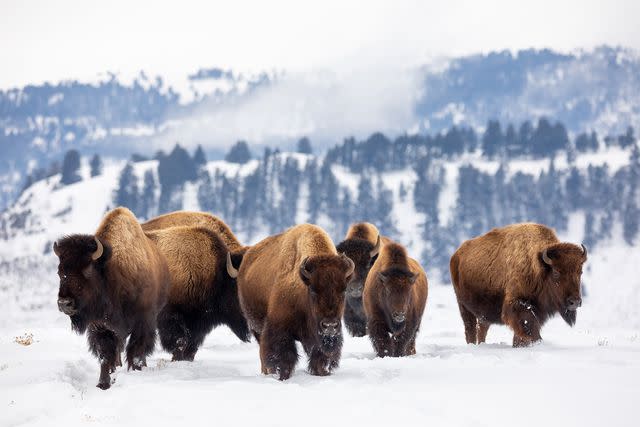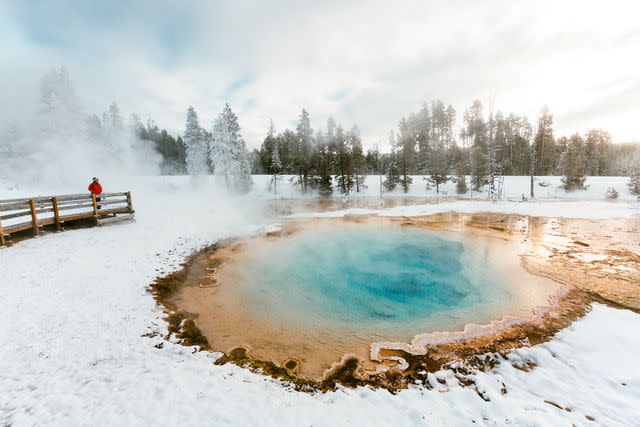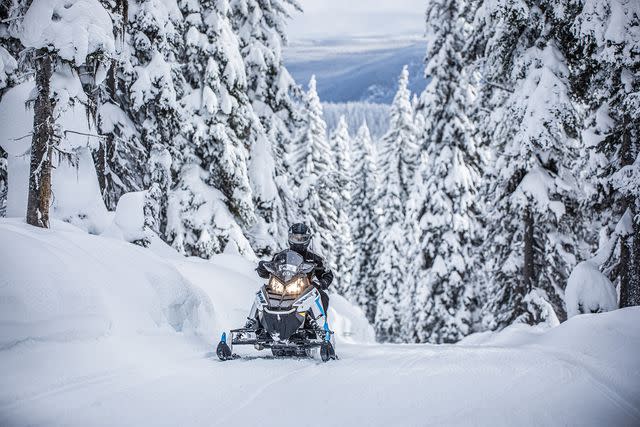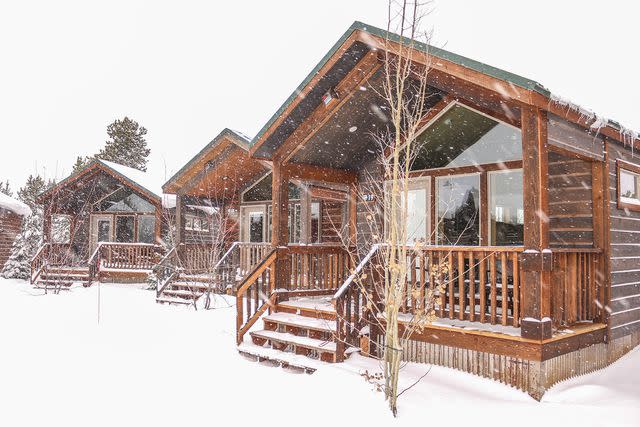Why You Should Book a Winter Trip to Yellowstone National Park
Say goodbye to crowds and hello to open spaces when you visit Yellowstone in the winter.
One of the country’s most popular national parks, Yellowstone draws more than three million visitors a year to witness spewing geysers, steaming pools, and incredible wildlife you'd have a hard time finding anywhere else in the U.S. It's home to more than half of the world’s geysers, including Old Faithful, which has erupted at least once every couple hours for decades. The park also contains the continent’s largest supervolcano, the Yellowstone Caldera.
The Yellowstone landscape is big and beautiful — rivers cut through dramatic canyons, and towering mountains provide an almost surreal backdrop to every excursion. The park’s expansive wilderness is home to treasured megafauna, from bears and wolves to herds of bison and elk, all of which are spotted regularly by visitors.

KenCanning/Getty Images
While summer is by far the most popular time to visit Yellowstone, all that beauty and wonder doesn’t go away when the snow begins to fall. Between December and March, the park evolves into a quiet winter wonderland — one with minimal crowds and plenty of open space. In fact, winter may just be Yellowstone’s best-kept secret. It requires a different approach and a bit more legwork, but the reward is a trip you won’t soon forget. Here's what you need to know about visiting Yellowstone in the off-season.
Related: The 25 Best National Parks in the U.S.
Getting to and Around Yellowstone in the Winter

ferrantraite/Getty Images
You can drive all over the park during its peak season, but it's a different story in the winter. Snow covers the roads, and avalanche danger is prevalent. The only part of Yellowstone National Park that remains open to cars year-round is the road between the north and northeast entrances — and even then, services are extremely limited. If you’re planning to drive yourself, check the park’s road status map before you go.
A better way to get around the park in the winter is by traveling over the snow on skis or snowshoes or by snowmobile or snowcoach. This mode of travel offers a completely different experience and lets guests get up close to the landscape and natural elements. You can typically opt for over-snow travel until March or April, after which the roads reopen.
Winter Activities in Yellowstone National Park
In the winter, Yellowstone National Park becomes a veritable playground for outdoor enthusiasts, wildlife fanatics, photographers, and adventure seekers. Here are some of the best things to do during your visit.
Skiing and Snowshoeing
There are miles and miles of trails throughout the park, some with a set track and others that will require you to break the trail yourself. Skiers and snowshoers are also permitted to travel on unplowed roads.
Many ski and snowshoe adventures start around Mammoth Hot Springs near the north entrance. You can rent ski and snowshoe gear from the Bear Den Ski Shop at the Mammoth Hot Springs Hotel or any outfitter outside the park. Anyone who isn't well-versed in avalanche safety should opt for a guided tour. As a bonus, tours usually include rental gear and transportation into the park. If you venture out without a guide, make sure the trails are open and conditions are safe to do so.
Snowmobiling and Snowcoach Tours

Courtesy of Delaware North Parks and Resorts
One of the most fun ways to see Yellowstone in winter is by snowmobile. Most people book a trip with a guide, as only four permits are allotted to non-commercially guided groups each day. Luckily, there are tons of outfitters who know the ins and outs of the park and can lead you to wide-open powder fields waiting to be explored.
If being out in the elements isn’t your cup of tea, you can book a snowcoach through one of the many local snowmobile and snowcoach outfitters in the area.
Seeing Old Faithful in the Winter
Watching Old Faithful erupt in the winter is pure magic. With a blanket of fresh snow and no crowds, you can fully experience the wonder of this powerful (and punctual) geyser. But, unlike in the summer, you’ll need to book a trip with a snowmobile or snowcoach company to get to the site from November to late April. Rest assured, seeing the juxtaposition of the fiery eruption against a white backdrop is well worth the extra effort.
Where to Stay in Yellowstone National Park in the Winter

Courtesy of Yellowstone Vacations
Winter lodging is limited in the park, but the Mammoth Hot Springs Hotel and Old Faithful Snow Lodge remain open. The latter is accessible only via over-snow transportation. Because rooms are limited at both lodges, make your reservation as far in advance as possible. You can also look at lodging in the nearby Montana towns of Gardiner, Silver Gate, and Cooke City.
Mammoth Campground near the park's north entrance is typically open for tent camping (with limited services) throughout the winter; however, it sustained flood damage in 2022 and has remained closed in 2023.
Related: 11 Best Places to Stay in Yellowstone National Park for Easy Access and Views
What to Pack for Yellowstone National Park in the Winter
With temperatures ranging from around zero to 20 degrees during the day, and dipping lower at night, layering is essential on your winter trip to Yellowstone. Pack long underwear, a wool sweater, a down jacket, and a wind- and waterproof outer layer (like a Gore-Tex jacket and pants). You’ll also want to bring synthetic or wool socks, gloves or mittens, a warm winter hat, and even gaiters to keep your feet warm and dry. Even though the temperatures can be frigid, the sun will likely be shining, so make sure to pack sunglasses and plenty of sunscreen.
For more Travel & Leisure news, make sure to sign up for our newsletter!
Read the original article on Travel & Leisure.
